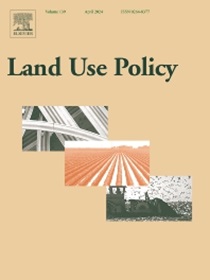From process to effects: An approach for integrating dominant and recessive transitions of rural residential land (RRL)
IF 6
1区 社会学
Q1 ENVIRONMENTAL STUDIES
引用次数: 0
Abstract
A complete course of rural residential land transition (RRLT) must correspond to the complex transition process itself and the multidimensional impacts arising from the transition, and it is essential to portray the complex laws of RRLT at multiple levels from a systemic perspective. In this study, a transition framework based on the "process-effects" perspective is presented to integrate the dominant and recessive transition of rural residential land (RRL) and analyse the transition characteristics from 2009 to 2021 in the Pinggu District of Beijing, a suburb of the metropolis. The results show that during the study period, the RRL in Pinggu District experienced a complex and drastic transition; when the proportion of RRL in construction land decreased, with the spatial layout tending to be decentralized as a whole, and the land use structure tended to be balanced and diversified. However, the comprehensive transition index of RRL is generally low, which indicates an inadequate transition. From the northeastern mountainous areas to the central semimountainous areas and then to the southwestern plains, the RRLT process is characterized by a progressive spatial evolution from single to complex. The overall effect of RRLT increased, with the most significant increase in economic effects, but the transition from rural nonagriculturalization to exogenous expansion also led to a decrease in social and ecological effects in some areas. The process and effects of RRLT are generally in a state of basic coordination, with a low level of synchronized development; process-lagging villages must adapt to the new demands of economic and social development on RRL adjustment at this stage, while effect-lagging villages must give full play to the spatial agglomeration effect of elements of sustainable development of RRL and enhance the effectiveness of land use. The findings provide new perspectives and new ideas for rural land planning practices in the context of rapid transformation.
从过程到效果:整合农村住宅用地(RRL)显性和隐性过渡的方法
一个完整的农村宅基地转型过程必须与复杂的转型过程本身以及转型所产生的多维度影响相对应,必须从系统的角度多层次地刻画农村宅基地转型的复杂规律。本研究提出了一个基于 "过程-效应 "视角的转型框架,将农村宅基地的显性转型和隐性转型结合起来,分析了北京市平谷区(大都市的郊区)从 2009 年到 2021 年的转型特征。结果表明,研究期内平谷区农村宅基地经历了复杂而剧烈的转型,建设用地中农村宅基地比重下降,空间布局整体趋于分散,用地结构趋于均衡和多样化。但 RRL 综合转型指数普遍偏低,表明转型不充分。从东北部山区到中部半山区,再到西南部平原,RRLT 的空间演化过程呈现出从单一到复合的渐进特征。RRLT的总体效应增加,其中经济效应的增加最为显著,但农村非农化向外源扩张的过渡也导致了部分地区社会和生态效应的下降。农村土地整治的过程与效果总体上处于基本协调状态,同步发展水平较低;过程滞后的村庄必须适应现阶段经济社会发展对土地整治的新要求,而效果滞后的村庄必须充分发挥土地整治可持续发展要素的空间集聚效应,提高土地利用效益。研究结果为快速转型背景下的农村土地规划实践提供了新视角和新思路。
本文章由计算机程序翻译,如有差异,请以英文原文为准。
求助全文
约1分钟内获得全文
求助全文
来源期刊

Land Use Policy
ENVIRONMENTAL STUDIES-
CiteScore
13.70
自引率
8.50%
发文量
553
期刊介绍:
Land Use Policy is an international and interdisciplinary journal concerned with the social, economic, political, legal, physical and planning aspects of urban and rural land use.
Land Use Policy examines issues in geography, agriculture, forestry, irrigation, environmental conservation, housing, urban development and transport in both developed and developing countries through major refereed articles and shorter viewpoint pieces.
 求助内容:
求助内容: 应助结果提醒方式:
应助结果提醒方式:


